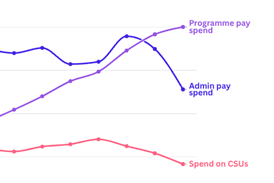Digital transformation and innovation will be key for facilitating a flexible healthcare model, but it is crucial that we go about adopting new technologies carefully and compliantly. By Hugo Stephenson
Sponsored by
The healthcare sector was met with several key challenges at the onset of the pandemic. Hospitals and clinics found themselves at peak capacity which led to appointments being delayed or cancelled. Due to strict national lockdowns and social distancing rules, many patients were unable to attend physical consultations and increased infection risk meant doctors were often unable to move freely around hospitals to deliver care. At the same time, resource constraints meant many healthcare workers were mobilised to work in unfamiliar environments – and needed rapid access to changing guidance to perform their duties.
All of this meant that the sector had to quickly move towards a flexible healthcare model, powered by a variety of digital healthcare technologies. Examples of such technologies include Induction Switch, an app based solution used by over 210,000 NHS doctors to streamline communication with colleagues; Induction Zesty, a portal used by 280,000 patients to book and access their appointments, read their clinical letters, store a copy of their clinical record and provide data to their care teams remotely; and Attend Anywhere, the video consultation system purpose built for healthcare and used by 90 per cent of NHS trusts throughout the UK.
While digital transformation has been a focus for the sector for years, the pandemic sped up efforts significantly – placing pressure on trusts and regions to rapidly evaluate quite complex digital tools against a number of important security, privacy and stability criteria.
Making sure that technologies entering the NHS and social care are safe, secure, interoperable and accessible is difficult at the best of times. How can NHS institutions safely and efficiently implement tools during the additional stress and time pressure of a pandemic? To simplify and harmonise the evaluation process for healthcare organisations across England, the NHSX created Digital Technology Assessment Criteria to instil confidence in staff and patients that the services they are using meet NHS standards. Working behind the scenes to uphold these principles are the partners and development teams creating today’s digital services.
So, what is DTAC and why are trusted partners important?
What is DTAC?
The NHSX launched DTAC to provide clarity on how digital tools will be assessed. The aim is to provide a new set of standards to streamline the adoption of “safe and innovative” technologies.
DTAC applies to all digital health technologies and was designed by bringing legislation and guidance together in five main areas: clinical safety; data protection; technical assurance; interoperability; and usability and accessibility.
Crucially, the assessment arms NHS teams with the information they need to decide what technologies they should be buying or recommending to patients. It also helps developers understand what is expected when it comes to building products for NHS and social care use.
By setting a national baseline, DTAC smooths ‘the path between development and procurement so that the NHS and social care may realise the benefits digital technology can bring’. As the sector moves towards a flexible healthcare model, DTAC encourages greater and faster uptake of digital services and ensures the tools being implemented by the NHS are interoperable, meaning that they can be easily integrated within existing systems and across departments.
Why the NHS needs trusted partners
There is no doubt that DTAC is an essential tool. For it to work, however, NHS partners and their development teams need to follow the assessment criteria carefully.
Attend Anywhere’s participation in the DTAC assessment process, for example, has allowed regions and trusts to save significant time during the evaluation phase of video consultation technology – enabling rapid roll out of transformational technology at a critical time for patients and providers. And, by reducing duplicative evaluation exercises, precious IT staff resources can remain focused on supporting systems that directly impact patient care.
Digital transformation and innovation will be key for facilitating a flexible healthcare model, but it is crucial that we go about adopting new technologies carefully and compliantly. DTAC is therefore a step in the right direction for ensuring a safe and flexible digital future – and responsible developers are at the forefront of protecting patients and providers.
Dr Hugo Stephenson, group executive director, Induction Healthcare





























No comments yet